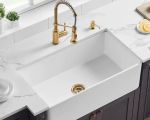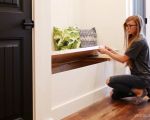How to Remodel a Bathroom with Eco-Friendly Products
Remodeling a bathroom is one of the most impactful ways to refresh your home, and when done with eco-friendly products, it can also be a sustainable investment. The bathroom is a space that sees a lot of water usage, so making green choices here can save you money, reduce your environmental footprint, and increase the overall value of your home. In this guide, I’ll share everything you need to know about remodeling your bathroom with eco-friendly products, from choosing sustainable materials to ensuring energy efficiency and reducing water waste.
1. Understanding Eco-Friendly Bathroom Remodeling
Before embarking on any remodeling project, it’s important to understand what makes a bathroom eco-friendly. Sustainable bathroom design focuses on minimizing environmental impact by using resources more efficiently, choosing non-toxic materials, and ensuring longevity. Some areas to focus on include reducing water usage, improving energy efficiency, and selecting products that have minimal environmental impact during manufacturing, use, and disposal. Let's dive into some specific strategies you can implement in your bathroom remodel.
2. Choose Water-Efficient Fixtures
One of the most significant contributors to water waste in a bathroom is inefficient fixtures. Replacing older toilets, faucets, and showerheads with water-efficient models can dramatically reduce your water consumption. Look for products labeled with the WaterSense label, which ensures that the fixture meets EPA standards for water efficiency. For example, low-flow toilets use less water per flush, while water-saving showerheads reduce flow without compromising water pressure. Replacing your bathroom fixtures with WaterSense-rated products is one of the easiest and most impactful steps you can take to make your bathroom more eco-friendly.
3. Invest in Energy-Efficient Lighting
Lighting plays a big role in a bathroom’s energy use, and switching to energy-efficient lighting can make a noticeable difference. LED bulbs are one of the most energy-efficient lighting options available. They use significantly less energy compared to incandescent or even compact fluorescent bulbs, and they last much longer. You can also consider installing dimmer switches, which allow you to adjust the lighting intensity and further reduce energy consumption. Natural light is another fantastic option—consider adding a skylight or larger windows to allow natural light to flood the space, reducing the need for artificial lighting during the day.
4. Use Sustainable Materials for Surfaces and Flooring
When selecting materials for your bathroom remodel, focus on products that are sustainably sourced, durable, and non-toxic. For countertops, look for options like recycled glass, bamboo, or reclaimed wood. These materials are both eco-friendly and stylish, offering unique looks that can enhance the design of your bathroom. For flooring, consider bamboo or cork, both renewable resources that are durable and moisture-resistant. If you prefer traditional tile, make sure it’s made from sustainable materials like porcelain or ceramic, which have a lower environmental impact than other types of tile.
5. Go Green with Non-Toxic Paints and Finishes
Conventional paints often contain harmful chemicals that can affect indoor air quality, so it’s important to choose paints and finishes that are low in volatile organic compounds (VOCs). VOCs are chemicals that can release into the air and cause respiratory problems, headaches, and other health issues. Look for paints labeled as low-VOC or no-VOC, which are safer for both your health and the environment. Many brands also offer non-toxic finishes and sealers for wood surfaces, giving you a wide range of options to make your bathroom healthier for you and the planet.
6. Incorporate Eco-Friendly Bathroom Accessories
Don’t forget the small details when remodeling your bathroom. Eco-friendly accessories can include things like reusable bathroom accessories, such as cloth towels instead of paper, bamboo toothbrushes, and natural bath products. When it comes to bath mats, opt for ones made from organic cotton or recycled materials. Consider adding a compost bin to encourage waste reduction, and if you’re in the market for shower curtains, choose one made from recycled materials or natural fibers instead of vinyl, which is harmful to the environment.
7. Consider Water and Energy Saving Appliances
If you’re looking for a bigger investment that can make your bathroom even more eco-friendly, consider installing water and energy-saving appliances. For instance, a tankless water heater can help reduce energy consumption by providing hot water on demand, rather than storing it in a tank. This not only saves energy but also prevents heat loss. Additionally, installing a more efficient ventilation system can help regulate humidity levels and prevent mold growth, ensuring your bathroom stays clean and healthy while using less energy.
8. Recycle and Repurpose Materials
During your bathroom remodel, don’t forget to recycle and repurpose as much as possible. Many items like old tiles, sinks, and cabinetry can be donated or reused in other parts of the home. Alternatively, you can recycle these items at designated recycling centers to prevent them from ending up in a landfill. Reusing materials is a great way to minimize your project’s environmental impact while also saving money.
9. Final Thoughts on Eco-Friendly Bathroom Remodeling
Remodeling your bathroom with eco-friendly products isn’t just about reducing your environmental footprint—it’s also about creating a healthier, more sustainable living space for you and your family. From water-efficient fixtures to non-toxic paints and recycled materials, every decision you make during the remodel can have a positive impact on the planet. By choosing sustainable materials, investing in energy-efficient appliances, and focusing on water conservation, you can transform your bathroom into a green oasis that benefits both your home and the environment.
For more ideas on eco-friendly remodeling or assistance with your project, feel free to visit Pine Cliff Resort for expert advice and recommendations.








